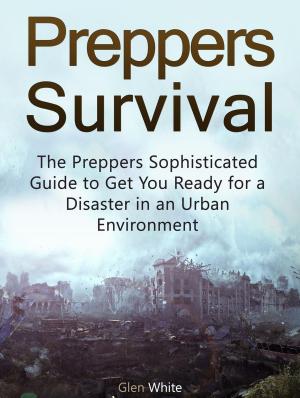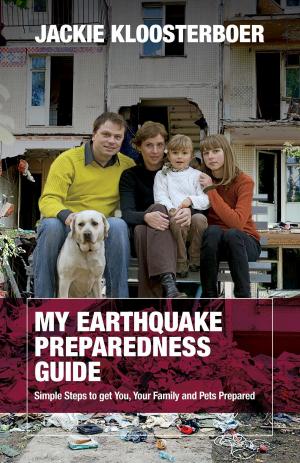The First Responder’s Field Guide to Hazmat & Terrorism Emergency Response
Nonfiction, Reference & Language, Reference, Guides & Handbooks| Author: | Jill Levy | ISBN: | 9781783014330 |
| Publisher: | Firebelle Productions | Publication: | April 24, 2014 |
| Imprint: | Firebelle Productions | Language: | English |
| Author: | Jill Levy |
| ISBN: | 9781783014330 |
| Publisher: | Firebelle Productions |
| Publication: | April 24, 2014 |
| Imprint: | Firebelle Productions |
| Language: | English |
Have the contents of an entire hazardous materials and WMD first responder course at your fingertips when you need it most ... at an incident.
This handy field guide covers most of the operational level first responder competencies identified in NFPA 472 and 473, with guidelines to help you recognize and safely manage any hazmat incident or WMD event. It's the perfect companion to the Emergency Response Guidebook (ERG).
The information is organized into fourteen chapters:
1. The 'Quick Reference Guide' contains a concise overview of your responsibilities as a first responder.
2. 'Recognizing and Responding to a Hazmat/WMD Incident' has detailed explanations and guidelines on each of the tasks listed in Chapter 1.
3. 'Labels, Placards, and Other Marking Systems' provides key points on each of the hazard classes and information on various other marking systems.
4. 'Container Recognition' provides clues about the types of products found in various containers and how these containers behave in an emergency. Look at both the general information about the type of container (nonbulk package, cargo tank, rail car, etc.) and specific information about the particular container(s) in question.
5. 'Assessing the Hazards' contains information on how hazardous materials cause harm, toxicological terms and exposure limits, properties of flammable liquids, chemical and physical properties, and guidelines for dealing with special hazmat situations.
6. 'Medical Management of Hazmat Exposures' has information on the risk of secondary contamination, patient decon, triage, health effects of hazardous materials commonly encountered, EMS treatment protocols, and medical support of hazmat response personnel.
7. 'Introduction to Terrorism' provides information on distinguishing a terrorist event from an accident and distinguishing between chemical and biological warfare agents.
8. 'Explosives Incidents' has information on how to recognize common explosives and initiation devices and guidelines on what to do upon discovery of a device or after detonation of an explosive.
9. 'Chemical Warfare Agents' has general information on how to deal with incidents involving chemical warfare agents, as well as more detailed information on nerve agents, blister agents, blood agents, choking agents, and riot control agents.
10. 'Biological Warfare Agents' provides general information on dealing with incidents involving biological warfare agents, as well as more detailed information on specific biological agents.
11. 'Nuclear Events' has information on dealing with incidents (intentional or accidental) involving radioactive materials.
12. 'Tactical Considerations' provides more information on defensive options and the use of foam.
13. 'Additional Considerations' includes guidelines on dealing with the media, minimizing liability, developing protective action messages, preserving evidence, and dealing with children.
14. 'Resources for Information and Assistance' provides information on various agencies that can help you manage a hazmat incident or terrorist event.
Five previous editions were released in print form. The book was updated for this 2014 eBook edition.
This handy field guide covers most of the operational level first responder competencies identified in NFPA 472 and 473, with guidelines to help you recognize and safely manage any hazmat incident or WMD event. It's the perfect companion to the Emergency Response Guidebook (ERG).
The information is organized into fourteen chapters:
1. The 'Quick Reference Guide' contains a concise overview of your responsibilities as a first responder.
2. 'Recognizing and Responding to a Hazmat/WMD Incident' has detailed explanations and guidelines on each of the tasks listed in Chapter 1.
3. 'Labels, Placards, and Other Marking Systems' provides key points on each of the hazard classes and information on various other marking systems.
4. 'Container Recognition' provides clues about the types of products found in various containers and how these containers behave in an emergency. Look at both the general information about the type of container (nonbulk package, cargo tank, rail car, etc.) and specific information about the particular container(s) in question.
5. 'Assessing the Hazards' contains information on how hazardous materials cause harm, toxicological terms and exposure limits, properties of flammable liquids, chemical and physical properties, and guidelines for dealing with special hazmat situations.
6. 'Medical Management of Hazmat Exposures' has information on the risk of secondary contamination, patient decon, triage, health effects of hazardous materials commonly encountered, EMS treatment protocols, and medical support of hazmat response personnel.
7. 'Introduction to Terrorism' provides information on distinguishing a terrorist event from an accident and distinguishing between chemical and biological warfare agents.
8. 'Explosives Incidents' has information on how to recognize common explosives and initiation devices and guidelines on what to do upon discovery of a device or after detonation of an explosive.
9. 'Chemical Warfare Agents' has general information on how to deal with incidents involving chemical warfare agents, as well as more detailed information on nerve agents, blister agents, blood agents, choking agents, and riot control agents.
10. 'Biological Warfare Agents' provides general information on dealing with incidents involving biological warfare agents, as well as more detailed information on specific biological agents.
11. 'Nuclear Events' has information on dealing with incidents (intentional or accidental) involving radioactive materials.
12. 'Tactical Considerations' provides more information on defensive options and the use of foam.
13. 'Additional Considerations' includes guidelines on dealing with the media, minimizing liability, developing protective action messages, preserving evidence, and dealing with children.
14. 'Resources for Information and Assistance' provides information on various agencies that can help you manage a hazmat incident or terrorist event.
Five previous editions were released in print form. The book was updated for this 2014 eBook edition.
Have the contents of an entire hazardous materials and WMD first responder course at your fingertips when you need it most ... at an incident.
This handy field guide covers most of the operational level first responder competencies identified in NFPA 472 and 473, with guidelines to help you recognize and safely manage any hazmat incident or WMD event. It's the perfect companion to the Emergency Response Guidebook (ERG).
The information is organized into fourteen chapters:
1. The 'Quick Reference Guide' contains a concise overview of your responsibilities as a first responder.
2. 'Recognizing and Responding to a Hazmat/WMD Incident' has detailed explanations and guidelines on each of the tasks listed in Chapter 1.
3. 'Labels, Placards, and Other Marking Systems' provides key points on each of the hazard classes and information on various other marking systems.
4. 'Container Recognition' provides clues about the types of products found in various containers and how these containers behave in an emergency. Look at both the general information about the type of container (nonbulk package, cargo tank, rail car, etc.) and specific information about the particular container(s) in question.
5. 'Assessing the Hazards' contains information on how hazardous materials cause harm, toxicological terms and exposure limits, properties of flammable liquids, chemical and physical properties, and guidelines for dealing with special hazmat situations.
6. 'Medical Management of Hazmat Exposures' has information on the risk of secondary contamination, patient decon, triage, health effects of hazardous materials commonly encountered, EMS treatment protocols, and medical support of hazmat response personnel.
7. 'Introduction to Terrorism' provides information on distinguishing a terrorist event from an accident and distinguishing between chemical and biological warfare agents.
8. 'Explosives Incidents' has information on how to recognize common explosives and initiation devices and guidelines on what to do upon discovery of a device or after detonation of an explosive.
9. 'Chemical Warfare Agents' has general information on how to deal with incidents involving chemical warfare agents, as well as more detailed information on nerve agents, blister agents, blood agents, choking agents, and riot control agents.
10. 'Biological Warfare Agents' provides general information on dealing with incidents involving biological warfare agents, as well as more detailed information on specific biological agents.
11. 'Nuclear Events' has information on dealing with incidents (intentional or accidental) involving radioactive materials.
12. 'Tactical Considerations' provides more information on defensive options and the use of foam.
13. 'Additional Considerations' includes guidelines on dealing with the media, minimizing liability, developing protective action messages, preserving evidence, and dealing with children.
14. 'Resources for Information and Assistance' provides information on various agencies that can help you manage a hazmat incident or terrorist event.
Five previous editions were released in print form. The book was updated for this 2014 eBook edition.
This handy field guide covers most of the operational level first responder competencies identified in NFPA 472 and 473, with guidelines to help you recognize and safely manage any hazmat incident or WMD event. It's the perfect companion to the Emergency Response Guidebook (ERG).
The information is organized into fourteen chapters:
1. The 'Quick Reference Guide' contains a concise overview of your responsibilities as a first responder.
2. 'Recognizing and Responding to a Hazmat/WMD Incident' has detailed explanations and guidelines on each of the tasks listed in Chapter 1.
3. 'Labels, Placards, and Other Marking Systems' provides key points on each of the hazard classes and information on various other marking systems.
4. 'Container Recognition' provides clues about the types of products found in various containers and how these containers behave in an emergency. Look at both the general information about the type of container (nonbulk package, cargo tank, rail car, etc.) and specific information about the particular container(s) in question.
5. 'Assessing the Hazards' contains information on how hazardous materials cause harm, toxicological terms and exposure limits, properties of flammable liquids, chemical and physical properties, and guidelines for dealing with special hazmat situations.
6. 'Medical Management of Hazmat Exposures' has information on the risk of secondary contamination, patient decon, triage, health effects of hazardous materials commonly encountered, EMS treatment protocols, and medical support of hazmat response personnel.
7. 'Introduction to Terrorism' provides information on distinguishing a terrorist event from an accident and distinguishing between chemical and biological warfare agents.
8. 'Explosives Incidents' has information on how to recognize common explosives and initiation devices and guidelines on what to do upon discovery of a device or after detonation of an explosive.
9. 'Chemical Warfare Agents' has general information on how to deal with incidents involving chemical warfare agents, as well as more detailed information on nerve agents, blister agents, blood agents, choking agents, and riot control agents.
10. 'Biological Warfare Agents' provides general information on dealing with incidents involving biological warfare agents, as well as more detailed information on specific biological agents.
11. 'Nuclear Events' has information on dealing with incidents (intentional or accidental) involving radioactive materials.
12. 'Tactical Considerations' provides more information on defensive options and the use of foam.
13. 'Additional Considerations' includes guidelines on dealing with the media, minimizing liability, developing protective action messages, preserving evidence, and dealing with children.
14. 'Resources for Information and Assistance' provides information on various agencies that can help you manage a hazmat incident or terrorist event.
Five previous editions were released in print form. The book was updated for this 2014 eBook edition.






![Cover of the book Practical Guide To Production Planning & Control [Revised Edition] by Jill Levy](https://www.kuoky.com/images/2014/july/300x300/9781501486630-O0m2_300x.jpg)








